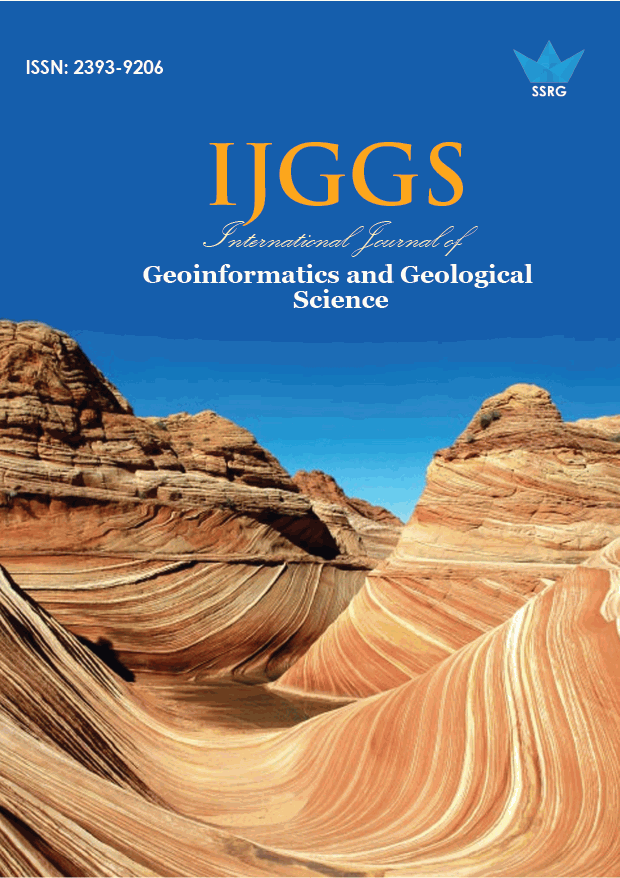Identification of Groundwater recharge potential zones in Thiruverumbur block, Trichy district using GIS and remote sensing

| International Journal of Geoinformatics and Geological Science |
| © 2016 by SSRG - IJGGS Journal |
| Volume 3 Issue 2 |
| Year of Publication : 2016 |
| Authors : Dr.Reshma Saujani Sharma |
How to Cite?
Dr.Reshma Saujani Sharma, "Identification of Groundwater recharge potential zones in Thiruverumbur block, Trichy district using GIS and remote sensing," SSRG International Journal of Geoinformatics and Geological Science, vol. 3, no. 2, pp. 6-11, 2016. Crossref, https://doi.org/10.14445/23939206/IJGGS-V3I4P102
Abstract:
Groundwater is deliberated as the desired source of water for facing the requirements of domestic, industrial and agricultural purposes. Due to its elongated residence time in the ground, low level of contamination, wide circulation, and accessibility within the reach of the end user.It is a precious resource of restricted extent.Moreover the prevailing wells are getting dried-up due to exhaustion of ground water table as the natural recharge is not sufficient. Groundwater recharge is a basic precondition for resourceful groundwater resource development and management, which is mainly significant for India with broadly predominant semi-arid and arid climate. Such precious groundwater can be used in a proper way hence accurate evaluation method is required. Suppose the natural recharge is not enough for the users, the authorized department have to meet with artificial recharge wherever it is necessary. For the process of constructing artificial recharge extents, the appropriate locations with hydro-geometric data will be required and also a suitable map showing such groundwater recharge potential zones for appropriate restore will be organized. Incorporated remote sensing and GIS can afford such appropriate platform for convergent analysis of various data sets for decision making in groundwater management and development. This paper proposed to recognize the groundwater recharge potential zones, to be used for better and enhanced groundwater resources. The various thematic layers deliberated are soil, land use and coverage, geomorphology, slope, drainage and contour density, which are organized using satellite imagery and other predictable data. Consequently, all thematic layers were combined using ArcGIS software to recognize the groundwater recharge potential zones and produce a map showing these groundwater recharge potential zones namely poor, moderate, good and excellent mainly based on the factors of the weights. The use of proposed methodology is demonstrated for a nominated study area Thiruverumbur block of Trichy district, Tamilnadu. This groundwater prospective information will be beneficial for effective identification of suitable locations for the process of extraction of groundwater.
Keywords:
Groundwater, Remote Sensing, GIS, recharge, thematic layers.
References:
[1] M.L.Waikar and Aditya P. Nilawar, 2014, Identification of Groundwater Potential Zone using Remote Sensing and GIS Technique, International Journal of Innovative Research in Science, Engineering and Technology, vol.4, issue.5, pp.no:12163-74.
[2] ShivajiGovind Patil1, NitinMahadeoMohite, 2014, Identification of groundwater recharge potential zones for a watershed using remote sensing and GIS, International journal of geomatics and geosciences, vol.4, no.3, pp.no: 485-98.
[3] Radhakrishnan. D, Ramamoorthy. P, 2014, Delineation of Groundwater Recharge Potential zones in Mailam Block, Villupuram district, Using GIS, International Journal of Water Research, vol.2(2), pp.no:71-75.
[4]Jothiprakash V., Marimuthu G., Muralidharan R. and Senthilkumar N, 2003, Delineation of potential zones for artificial recharge using GIS. J. of Indian Society of Remote Sensing, 31(1), pp 37-46.
[5] Narendra K., RaoNageswaraK. and LathaSwarna P, 2013, Integrating remote sensing and GIS for identification of groundwater prospective zones in the Narava basin, Visakhapatnam region, Andhra Pradesh. Journal of Geological Society of India, 81(2), pp 248-260.
[6]Subagunasekar M. and SashikkumarM. C, 2012, GIS for the assessment of the groundwater recharge potential zone in Karunakulam block, Thoothukudi district, Tamilnadu, India, International Journal of Current Science, 1, pp 159-162.
[7]Binay Kumar and Uday Kumar, 2011, Groundwater Recharge zonation mapping and modelling using Geomantic techniques, International Journal of Environmental Sciences, 1(7), pp 1670-1681.
[8] Chaudhary B. S., Manoj Kumar, Roy A. K. and Ruhal D. S., 1996, Applications of remote sensing and geographic information systems in groundwater investigations in Soha block, Gurgaon district, Haryana (India), International Archives of Photogrammetry and Remote Sensing, 31(B6), pp 18-23.
[9] Mondal Nepal C., Singh Vijay P. and SankaranSomayaji, 2011, Demarcation of prospective groundwater recharge zones in hard rock area from Southern India. Science Research Essays,6(16), pp 3539-3552.
[10]Sarup Dr. Jyoti, Tiwari Manish K. and KhatediyaVardichand, 2011, Delineation of groundwater prospect zones and identification of artificial recharge sites using geospatial technique. , International Journal of Advance Technology and Engineering Research, 1(1), pp 6-20.
[11]Balachandar D., Alaguraja P., Sundaraj P., Rutharvelmurthy K. and Kumaraswamy K.,2010, Application of Remote Sensing and GIS for Artificial Recharge Zone in Sivaganga District, Tamilnadu, India, International Journal of Geomatics and Geosciences, 1(1), pp 84-97.
[12] BremaJ. and Prince Arulraj G., 2012, Identification of sites suitable for artificial recharging and groundwater flow modeling in Noyyal river basin, Tamilnadu, India. International Journal of Sustainable Development, 3(8), pp 45- 58.
[13] Mishra Rajat C., Chandrasekhar Biju and NaikRanjitsingh D, 2010, Remote Sensing and GIS for Groundwater Mapping and Identification of Artificial Recharge Sites. Geo Shanghai International Conference, pp 216-223.
[14]JavedAkram and MushtaqHussainWani, 2009, Delineation of groundwater potential zones in Kaknud Watershed, Eastern Rajasthan, Using Remote Sensing and GIS Techniques. Journal of Geological Society of India, 73(2), pp 229-236.
[15] BasavarajHutti and Nijagunappa.R.,Identification of groundwater Potential Zone using Geo-informatics in Ghataprabha basin, North Karnataka, India. Int. Jor. Of Geomatics and geosciences 2, 0976-4380, 2011.
[16]Prabir Mukherjee, Chander Kumar Singh and Saumitra Mukherjee “Delineation of Groundwater Potential Zones in Arid Region of India, A Remote Sensing and GIS Approach”. Water Resource Manage 26:2643–2672, 2011.
[17]Preeja K. R., Sabu Joseph, Jobin Thomas and Vijith H., “Identification of Groundwater Potential Zones of a Tropical River Basin (Kerala, India) Using Remote Sensing and GIS Techniques”. J Indian Soc Remote Sens. 39(1):83-94, 2011.
[18]Sparks B.W., Landform in arid and semi-arid climates: Geomorphology, 2nd edition, (Longman Group Ltd.), pp 335- 341, 1960.
[19]Yammani S., “Groundwater quality suitable zones identification: application of GIS, Chittoor area, Andhra Pradesh, India”. EnvGeol, 53(1):201–210, 2007.

 10.14445/23939206/IJGGS-V3I4P102
10.14445/23939206/IJGGS-V3I4P102